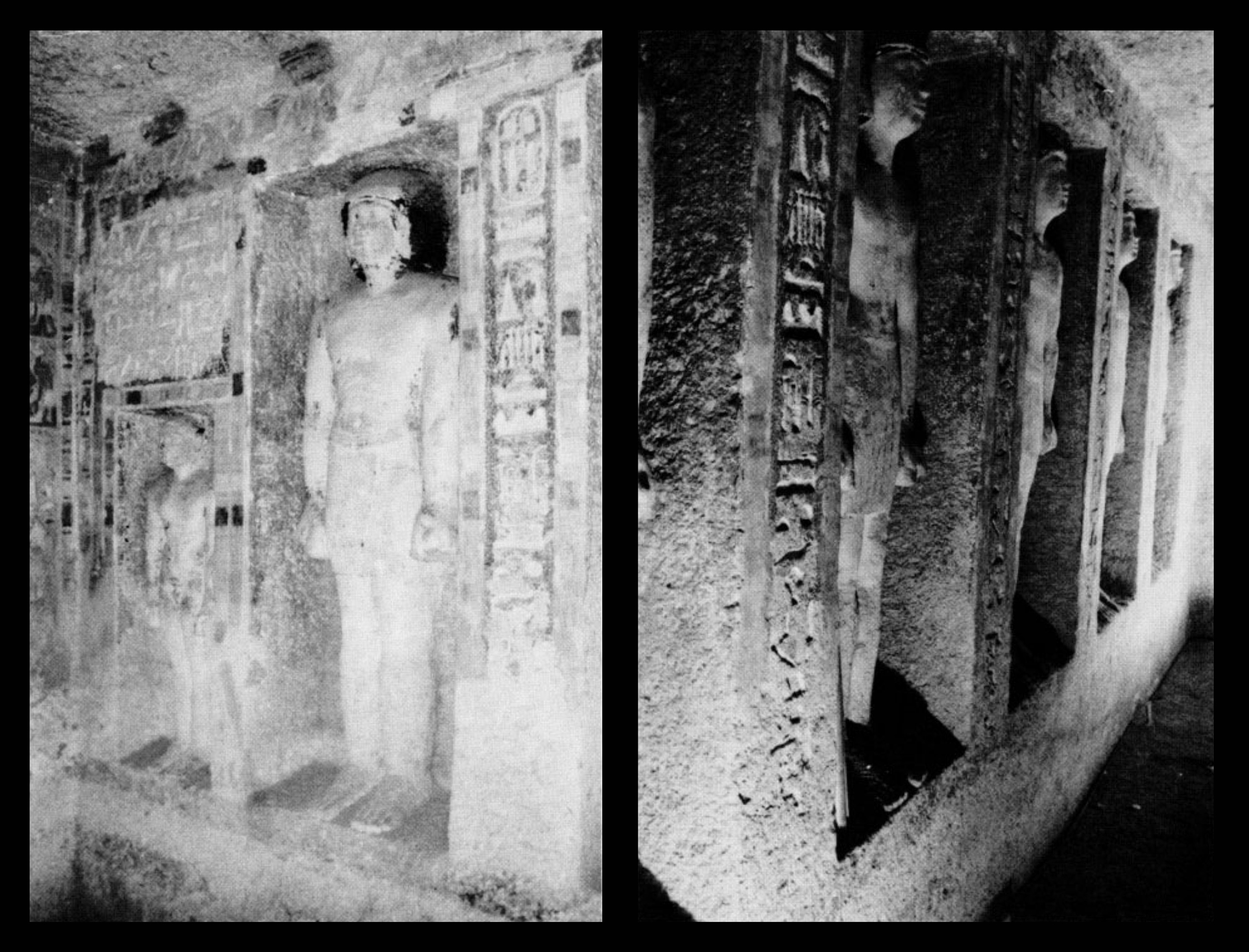The Mastabas of Qar and Idu G 7101 and 7102 - Digitally Revised and Enhanced Edition
Part II - Idu G 7102
Section 3.1 - Offering Chamber - Doorway
Doorway to the Offering Chamber in relation with area north of G7110-7120; Qar(G7101) and Idu (G7102) (click to enlarge)

Pl. XXI a. Idu, east wall, north section (left), Pl. XXI b. Idu, east wall, central and south section (right)
Rock-cut throughout, decorated walls sized with plaster to imitate white limestone. Reached through a doorway from the north in the center of the south face of the Inner Court (D). The chamber is 1.30 m. wide and 4.20 m. long, oriented north-south (pls. XXI, XXIX c), with a vaulted roof painted to imitate red granite, 1.85 m. high at walls.
0.60 m. wide and 0.70 m. deep, 1.58 m. high outside, 1.46 m. high inside, with drum between. The sill is .22 m. above the floor of the chamber and .05 m. above that of the exterior court. On both east and west jambs are standing figures of Idu, facing north, with inscriptions above and in front of them.
Pl. XVI d. Idu, north jamb, entrance to offering chamber (left), Pl. XVI e. Idu, south jamb, entrance to offering chamber (right)
Idu is shown facing outward to the right, wearing a short wig, a midcalf skirt with horizontal pleating and with belt, and holding a long staff diagonally in front of him with his left hand and a short scepter horizontally in his right hand. He has a large, pendulous breast, and a roll of fat extends just above the skirt at about the level of the navel. His right shoulder is bent toward the front. Above him is the text: imꜣḫw ḫr nṯr ꜥꜣ ẖry tp nswt mdw rḫyt iwn Knmt sš ꜥ nswt Idw, “one well-provided before the great god, he who is at the head of the king, staff of the rekhyet-people, pillar of Kenmet, king’s letter scribe Idu.” In front of him is the vertical text: i s nb ꜥḳtyfy r is pn ny wꜥb.n.f mr wꜥb n nṯr, iw ir.t(i) n.f ḫsft ḥr.s ḏw, “O every man who shall enter this tomb, not purifying himself like the purification for a god, one shall execute a punishment for him on account of it painfully.”
The variants of this formula are discussed by Edel, MDIK 13 (1944) 4-8. The consistent use of the introductory ir with the formula suggests that the initial i should be read as ir.
Idu is shown facing outward, to the left, wearing a larger full wig, broad collar, and leopard skin garment over a short skirt. The right hand with a bracelet on the wrist holds a long staff diagonally and the left a scepter horizontally; the latter appears to pass behind him in such representations when the figure faces left. Above him is the text: imy-r sš mrt imꜣḫw ḫr nṯr ꜥꜣ sš nswt ḫft ḥr Idw, “overseer of the scribes of the meret-serfs, one well-provided before the great god, king’s letter scribe in the presence Idu.” On a smaller scale before him is a male figure facing the same direction and wearing a short skirt and broad collar with the identifying text: sꜣ.f mry.f sꜣb sš imꜣḫw Ḳꜣr, “his beloved son, the sꜣb-official, the scribe, the well-provided Qar."
See Fischer, in Yale University Art Gallery Bulletin 24 (1958) 34.



%20(ground%20map).jpg)




.jpg)
%20Pl.-XVI-d.-Idu%2C-north-jamb%2C-entrance-to-offering-chamber.jpg)

-Pl.-XVI-d.-Idu%2C-north-jamb%2C-entrance-to-offering-chamber.jpg)
0 comment(s)
Leave a comment(We'll keep your email address private)